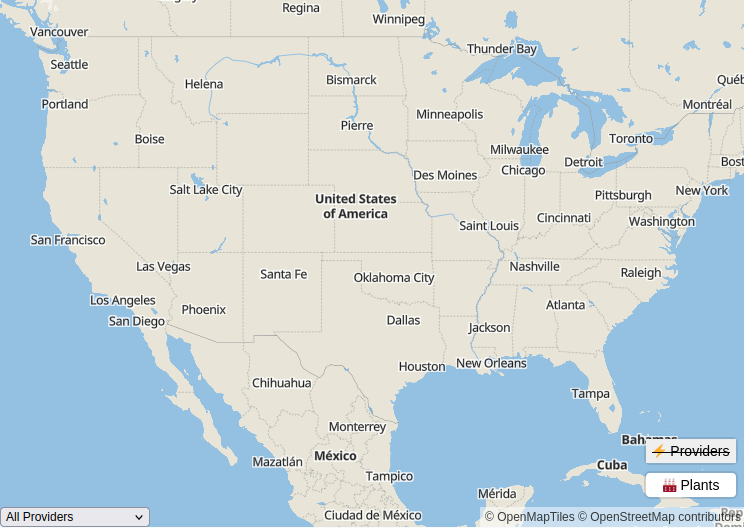Harrisonburg city, Virginia Electricity Rates & Statistics
Electricity Rates, Plans & Statistics
High Power Bills?
Reduce or replace your electricity bill with solar
Harrisonburg city, Virginia Electricity Overview
With total production of 3,328.08 megawatt hours, Harrisonburg city is the 76th highest generator of electricity of all 133 counties in the state.
With 52,062 residents within its borders and 3,328.08 megawatt hours produced per year, Harrisonburg city has a per capita production of 0.06 megawatt hours. The city ranks 77 highest megawatt hour per capita amount in Virginia.
Harrisonburg city experienced a 5.86% drop in CO2 emissions per capita over the most recent year.
Harrisonburg city is ranked as the 906th highest electricity consuming county out of 3230 counties in the United States with over 700,000 megawatt hours being consumed by residents who live there.
As the 43rd highest county in Virginia for non-renewable generation per capita, Harrisonburg city produces 0.06 megawatt hours per person a year.
Harrisonburg city released 228,521,591.49 kilograms of CO2 gases from electricity consumption, which ranks it as the 1086th worst polluting county out of 3230 counties in the country.
ENERGY CONSUMPTION
Total Consumption
779,059 MWh
Consumption per Capita
14.96 MWh
ENERGY PRODUCTION
Total Production
3,328 MWh
Production from Non-Renewable Energy
3,328 MWh
Production per Capita
0.06 MWh
EMISSIONS
CO2 Emissions
228,521,591 kg
CO2 Emissions per Capita
4,389.41 kg
Harrisonburg, VA Electricity Overview

Harrisonburg's inhabitants purchase electricity for, on average, 11.35 cents per kilowatt hour. Luckily, this is 20.49% lower than Virginia's average price of 14.28 cents, which ranks the city 2nd best for average electricity price out of 676 cities in Virginia. There is a deficiency of 775,731.16 megawatt hours in the city because of citizens consuming 23308.67% more electricity than the city's electricity plants produce. The city is ranked 31st in Virginia in total electricity produced from power generating plants within its borders, with 3,328.08 megawatt hours generated.
Harrisonburg is the 17th highest ranked city in the state out of 676 when it comes to total pollution from electricity use, with the city emitting 228,521,591.49 kilograms of CO2 emissions. This total also results in a ranking of 19th worst in Virginia for emissions per resident from electricity use, with an average of 4,389.41 kilograms of emissions per person. Distillate Fuel Oil is the primary fuel in Harrisonburg, with 100.00% of electricity generation coming from the fuel. Harrisonburg has 2 power generation plants, which is the 7th most for a city in the state.
Average Residential Electricity Bills & Rates in Harrisonburg
Harrisonburg residential electric rates are highest in January and the highest average bill is in January.
Historical Electricity Rates:
Electric Companies With Service in Harrisonburg, Virginia
| Provider | Service Type | Residential Rate (¢) | Residential Average Bill ($) | City Production (MWh) | Residential Sales (MWh) | Residential Revenues ($) |
|---|---|---|---|---|---|---|
| Harrisonburg Electric | BUNDLED | 11.35 | 109.82 | 3,328.08 | 208,840 | 23,708,000 |
Zips with electric coverage in Harrisonburg, Virginia include: 22801, 22802, 22807
Sign up for our newsletter, Watts Up in Energy, to receive updates on the latest energy news.
Electricity Production in Harrisonburg city, Virginia
Power Plants in Harrisonburg city, Virginia
| Plant | City/County | State | Primary Fuel Type | Production (MWh) | Emission (kg) | Emissions per MWh | Toxic Chemical Release | Closing Date |
|---|---|---|---|---|---|---|---|---|
Mount ClintonHarrisonburg Electric (100.00%) | Harrisonburg | VA | Distillate Fuel Oil | 2,002.14 | 1,986,757.89 | 992.32 | ||
Pleasant Valley (VA)Harrisonburg Electric (100.00%) | Harrisonburg | VA | Distillate Fuel Oil | 1,325.94 | 1,427,357.16 | 1,076.49 |
Harrisonburg city, Virginia Details
Harrisonburg city's electricity use results in CO2 emissions totaling 228,521,591.49 kilograms, which is 40th largest amount in Virginia out of 133 counties. This total also results in a ranking of 34th highest in the state for emissions per citizen with an average of 4,389.41 kilograms of emissions per person. Electricity generating facilities in the county primarily use Distillate Fuel Oil, which accounts for 100.00% (or 3,328.08 megawatt hours) of the fuel sources used for electricity production in the county. Harrisonburg city is home to 2 power producing plants, which is the 29th most plants within a county in Virginia.
FAQ
What electricity company is the largest supplier in Harrisonburg city, Virginia?
By total customer count, Harrisonburg Electric is the largest electricity supplier in Harrisonburg city, Virginia.
Which electricity companies offer service in Harrisonburg city, Virginia?
| County Customers Rank | Provider | Est. County Customers |
|---|---|---|
| 1 | Harrisonburg Electric | 21,567 |
How many power plants are located within Harrisonburg city, Virginia?
Harrisonburg city, Virginia has 2 active power plants generating electricity for the county and other surrounding areas.